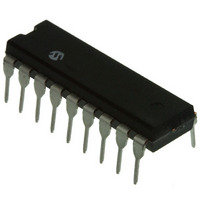PIC16F716-I/P Microchip Technology, PIC16F716-I/P Datasheet - Page 19

PIC16F716-I/P
Manufacturer Part Number
PIC16F716-I/P
Description
IC PIC MCU FLASH 2KX14 18DIP
Manufacturer
Microchip Technology
Series
PIC® 16Fr
Datasheets
1.PIC16F616T-ISL.pdf
(8 pages)
2.PIC16F688T-ISL.pdf
(688 pages)
3.PIC16F716-ISO.pdf
(136 pages)
4.PIC16F716-ISO.pdf
(12 pages)
5.PIC16F716-ESO.pdf
(126 pages)
Specifications of PIC16F716-I/P
Program Memory Type
FLASH
Program Memory Size
3.5KB (2K x 14)
Package / Case
18-DIP (0.300", 7.62mm)
Core Processor
PIC
Core Size
8-Bit
Speed
20MHz
Peripherals
Brown-out Detect/Reset, POR, PWM, WDT
Number Of I /o
13
Ram Size
128 x 8
Voltage - Supply (vcc/vdd)
2 V ~ 5.5 V
Data Converters
A/D 4x8b
Oscillator Type
Internal
Operating Temperature
-40°C ~ 85°C
Processor Series
PIC16F
Core
PIC
Data Bus Width
8 bit
Data Ram Size
128 B
Interface Type
RS- 232/USB
Maximum Clock Frequency
20 MHz
Number Of Programmable I/os
13
Number Of Timers
3
Operating Supply Voltage
2 V to 5.5 V
Maximum Operating Temperature
+ 85 C
Mounting Style
Through Hole
3rd Party Development Tools
52715-96, 52716-328, 52717-734
Development Tools By Supplier
PG164130, DV164035, DV244005, DV164005, PG164120, ICE2000
Minimum Operating Temperature
- 40 C
On-chip Adc
4-ch x 8-bit
Package
18PDIP
Device Core
PIC
Family Name
PIC16
Maximum Speed
20 MHz
Lead Free Status / RoHS Status
Lead free / RoHS Compliant
For Use With
I3-DB16F716 - BOARD DAUGHTER ICEPIC3AC162054 - HEADER INTERFACE ICD2 16F716ACICE0202 - ADAPTER MPLABICE 18P 300 MILAC164010 - MODULE SKT PROMATEII DIP/SOIC
Eeprom Size
-
Connectivity
-
Lead Free Status / Rohs Status
Lead free / RoHS Compliant
Available stocks
Company
Part Number
Manufacturer
Quantity
Price
Company:
Part Number:
PIC16F716-I/P
Manufacturer:
MICROCHIP
Quantity:
5 373
Part Number:
PIC16F716-I/P
Manufacturer:
MICROCHIP/微芯
Quantity:
20 000
2.3
The Program Counter (PC) is 13 bits wide. The low byte
comes from the PCL register, which is a readable and
writable register. The high byte (PC<12:8>) is not directly
readable or writable and comes from PCLATH. On any
Reset, the PC is cleared. Figure 2-3 shows the two
situations for the loading of the PC. The upper example
in Figure 2-3 shows how the PC is loaded on a write to
PCL (PCLATH<4:0> → PCH). The lower example in
Figure 2-3 shows how the PC is loaded during a CALL or
GOTO instruction (PCLATH<4:3> → PCH).
2.3.1
Executing any instruction with the PCL register as the
destination
Counter PC<12:8> bits (PCH) to be replaced by the
contents of the PCLATH register. This allows the entire
contents of the program counter to be changed by
writing the desired upper 5 bits to the PCLATH register.
When the lower 8 bits are written to the PCL register, all
13 bits of the program counter will change to the values
contained in the PCLATH register and those being
written to the PCL register.
A computed GOTO is accomplished by adding an offset
to the program counter (ADDWF PCL). Care should be
exercised when jumping into a look-up table or
program branch table (computed GOTO) by modifying
the PCL register. Assuming that PCLATH is set to the
table start address, if the table length is greater than
255 instructions or if the lower 8 bits of the memory
address rolls over from 0xFF to 0x00 in the middle of
the table, then PCLATH must be incremented for each
address rollover that occurs between the table
beginning and the target location within the table.
For more information refer to Application Note AN556,
“Implementing a Table Read” (DS00556).
2.3.2
The CALL and GOTO instructions provide 11 bits of
address to allow branching within any 2K program
memory page. When doing a CALL or GOTO instruction,
the upper bit of the address is provided by
PCLATH<3>. When doing a CALL or GOTO instruction,
the user must ensure that the page select bit is
programmed so that the desired program memory
page is addressed. If a RETURN from a CALL instruction
(or interrupt) is executed, the entire 13-bit PC is pushed
onto the stack. Therefore, manipulation of the
PCLATH<3> bit is not required for the RETURN
instructions (which POPs the address from the stack).
© 2007 Microchip Technology Inc.
PCL and PCLATH
MODIFYING PCL
PROGRAM MEMORY PAGING
simultaneously causes the
Program
FIGURE 2-3:
2.4
The stack allows a combination of up to 8 program calls
and interrupts to occur. The stack contains the return
address from this branch in program execution.
Mid-range devices have an 8-level deep x 13-bit wide
hardware stack. The stack space is not part of either
program or data space, and the Stack Pointer is not
readable or writable. The PC is PUSHed onto the stack
when a CALL instruction is executed or an interrupt
causes a branch. The stack is POPed in the event of a
RETURN, RETLW or a RETFIE instruction execution.
PCLATH is not modified when the stack is PUSHed or
POPed.
After the stack has been PUSHed 8 times, the ninth
push overwrites the value that was stored from the first
push. The tenth push overwrites the second push (and
so on).
12
12 1110
PCH
PCH
2
Stack
PCLATH<4:3>
PCLATH<4:0>
5
PCLATH
PCLATH
8 7
8 7
LOADING OF PC IN
DIFFERENT SITUATIONS
PCL
PIC16F716
PCL
11
8
Opcode <10:0>
DS41206B-page 17
ALU
0
0
Instruction with
PCL as
Destination
GOTO, CALL















